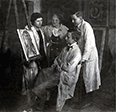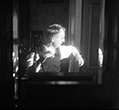




1904-1914
1915-1916
1916-1918
1919
1919-1922
1923-1924
until 1927
from 1927
1939-1945
from 1945
from 1955
1968
his grandfather was a metalsmith who ran a smithery,
his father was a self-employed master-painter.
primary schooling in Hagen, followed by 1 year of business school.
Städt. Malerfachschule (professional school for painting) in Hagen where he attends
classes in drawing, painting and design.
compulsary military service in Russia and France; he falls sick with a lung infection in
the trenches of the Western front and remains in an army hospital;
After the end of the war he returns to Hagen to continue his studies at the
Malerfachschule until 1919.
Inspired by the Hagener Impuls of Karl Ernst Osthaus, who showed the first big
exhibition of Lyonel Feininger in Hagen's Museum Folkwang, and supported by his
teacher Max Austermann, he takes up studies at the newly founded Bauhaus in
Weimar, starting the winter semester of 1919.
studies at the Staatliches Bauhaus in Weimar with Johannes Itten and Lyonel Feininger;
he attends the newly established preliminary course of Johannes Itten, along with his
fellow artists from Hagen, Reinhard Hilker and Erna Mayweg. He participates in
exhibitions for the first time in 1920; the development of the illness he caught in the
war forces him to interrupt his studies and leave for recuperation in Meran (South
Tyrol).
Back at the Bauhaus, he continues his studies until 1922, working in the print
department of Lyonel Feininger, who has a formative influence on his artistic
development.
he spends these years traveling with friend, Hugo Isenberg, in southern Germany,
Austria and Italy. They earn their living with restoration work.
In 1924 he left for another recuperation stay in Meran.
In Hagen, Hannes Behler (JOB), Albert Buske, August Agatz and Will Lammert are among
his fellow artists. He encourages his friend August Agatz to visit the Bauhaus in Dessau;
also Albert Buske, Max Gebhard and Waldemar Alder follow to undertake their studies
there.
With numerous trips to Weimar, Dessau and Berlin he keeps a fervent contact to the
Bauhaus until 1933.
member of the artist group "Hagenring" and participation in exhibitions.
photography and film dominate his artistic work;
he establishes a photo and film studio and creates "perpelleristische Filme" (propellering
rotating animations) and cartoons on 35mm film, which he processes himself.
After his father's death, he earns his livelihood in his mother's small paint and glass shop,
alongside his continuing artistic work.
In the early 1930's he also has, besides his film studio, a second small studio in Hagen-
Wehringhausen, where the young painter Emil Schumacher (1912-1999), who was living
in the neighborhood, was one of his frequent guests; he also shared with him a frequent
artistic exchange until the mid-1950's.
In 1933 he denies studio visit and exhibition participation towards the Nazis.
In 1938 he marries Annemarie Brocksieper, their first son Utz is born in 1939,
followed by their son Klaus († 1995) born in 1940.
compulsory military service at the Eastern and Western fronts.
In 1944 his house and studio are destroyed in bombing raids; his paintings, drawings,
photos and films are destroyed with only fragments remaining.
he resumes his artistic work; linear drawings and charcoal drawings of image substance
are developed.
He discovers the "Perspektive der nahen Dinge" (perspective of close objects) utilizing
"Tastendes Sehen" (tactile viewing), and henceforth paints his pictures based on this view.
Until his death he earns his living in his small paint & glass shop. He resumes contact to his
friends from the Bauhaus, writes to Maria Rasch and to Gustavo Keller-Ruiz in Chile. 1950 an
exchange of letter ensues between him and Lyonel Feininger in New York.
1954 first trip to Weimar following the war where he meets friends from his time at the
Bauhaus, including Harry Scheibe and Martin Pohle;
In Weimar he gets to know Weimar-based graphic artist and lyricist Arno Fehringer
(1907-1974) with whom he keeps an intensive exchange of letters until his death.
his late work develops: every day objects with signs of usage, portraits and self portraits
focused on imaging the substance, are the central theme of his pastel drawings which he
creates following his formula "FORM, FARBE + MATERIE" (shape, colour + substance).
He dies in Hagen on April 24th.
A summary of all periods of his work - drawings done at the Bauhaus in 1919, early
photographs, fragments of film works, linear charcoal- and pastel drawings, as well as
the exchange of letters with Lyonel Feininger from 1950, are today owned by the
Klassik Stiftung Weimar / Bauhaus Museum.
Various pastels, drawings and film works of Heinrich Brocksieper are contained in the
collection of Stiftung Bauhaus Dessau.